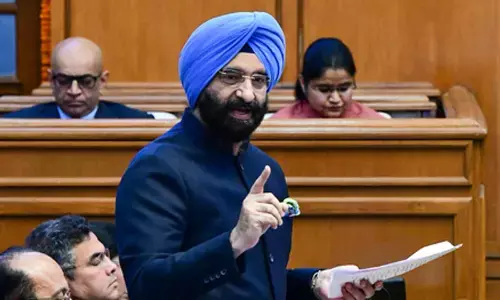Making India self-reliant in defence

MoD notified a new list of 101 weapons and systems that will come under a phased import ban over the next five years.
On April 7, Ministry of Defence (MoD) notified a new list of 101 weapons and systems that will come under a phased import ban over the next five years. This list is the third positive indigenisation list which is in continuation of the first list of 101 items and the second list of 108 items. They were released earlier on 21 August, 2020 and 31 May, 2021 respectively.
The publishing of three consecutive lists over 20 months or so to enhance the pace of indigenisation and create opportunities for the domestic defence manufacturing industry by banning imports to reduce its over-dependence on Russia for weapons is no doubt laudable. However, whether or not India is in a position to meet the timelines for producing these items indigenously could well turn out to be a gamble.
Of the 310 items included in these three lists, the latest list includes sensors, light-weight tanks, naval utility helicopters, patrol vessels, anti-ship missiles and anti-radiation missiles, rockets, torpedoes, loitering munitions, mounted artillery gun systems to medium altitude long endurance unmanned aerial vehicles (UAVs).
The weapons and systems covered in the first two lists include artillery guns, missile destroyers, ship-borne cruise missiles, light combat aircraft, light transport aircraft, long-range land-attack cruise missiles, basic trainer aircraft, multi-barrel rocket launchers, assault rifles, sniper rifles, mini-UAVs, specified types of helicopters, next-generation corvettes, airborne early warning and control (AEW&C) systems, tank engines and medium-range surface to air missile systems.
These weapons and platforms will be indigenised in phases between December 2022 and December 2027. The domestic industry is likely to receive orders worth Rs 2,10,000 crore in the next five years as a result of the third list. Since the notification of the first two lists, contracts for 31 projects worth Rs 53,839 crore have already been signed by the armed forces. Also, acceptance of necessity (AoN) for 83 more projects worth Rs 1,77,258 crore has been accorded, and the deals worth Rs 2,93,741 crore would be taken up in the next five to seven years.
Overdependence on Russia
India is the world's largest buyer of Russian weapons. According to the Stockholm International Peace Research Institute (SIPRI), two-thirds of Indian military equipment is still of Soviet/Russian origin. India's military hardware is still almost 70 per cent Russian and the cost to replace this equipment is just too much. In 2021, India cleared a proposal to make over 6 lakh AK-203 assault rifles in partnership with Russia. In 2019, India sealed a $3 billion deal with Russia for leasing a nuclear-powered submarine for the Indian Navy for 10 years. Even though India is trying to diversify its defence imports, it still pays Russia billions to buy defence equipment.
Why this push for self-reliance now?
The list has come out at a time when complications stemming from the wide-ranging sanctions slapped on Russia by the US and the NATO allies on the back of the war in Ukraine have posed new challenges for the India-Russia defence relationship It also test India's military preparedness and assigned new urgency to reduce dependence on imported military hardware to stay battle-ready.
India has always been dependent on developed countries to get modern defence equipment. The lack of domestic defence manufacturing has led to India paying huge amounts to get these items. And, in many cases, these weapons and systems turn out to be outdated and ill-equipped when compared with other top militaries in the world. Moreover, imported weapon systems are prone to security breaches. The Defence Minister, Rajnath Singh highlighted the pitfalls of operating imported weapons and systems whose software codes could be compromised and prove to be dangerous for the country's security apparatus as it would open a window of vulnerability.
The government is keen to reduce dependence on imported military platforms as Indian armed forces are projected to spend around 130 billion US dollars in capital procurement over the next five years. For that, the Ministry of Defence has set a goal of a turnover of $25 billion in defence manufacturing in the next five years.
Defence Ministry has also has earmarked 25 per cent of the domestic capital acquisition budget worth Rs. 21,149 crore for the sector. It comes two months after India set aside 68 per cent of the capital procurement budget, which is Rs. 1.24 lakh crore for the entire domestic industry during 2022-23 to promote self-reliance in the defence sector. India allocated Rs. 5.25 lakh crore for military spending in this year's budget, including a total capital budget of Rs.1.52 lakh crore for the modernisation of the armed forces. Accordingly, an amount of Rs. 84,597.89 crore was allocated specifically for the domestic defence industry in the current Financial Year (FY).
Positive indigenisation lists not enough
This policy initiative has been hailed by the domestic industry in the belief that banning imports was a necessary pre-condition for achieving indigenisation, self-reliance, and higher exports. This initiative also raises questions about the future business opportunities for the foreign companies and the government's efforts to attract higher Foreign Direct Investment (FDI) following the raising of the cap on investment through the automatic route to 74 per cent.
According to the government premise, the purpose of notifying the lists is to sensitise the domestic industry about the future needs of the armed forces so that it could meet the requirement when the occasion arises after the embargo kicks in. In addition to this, the assumption of the Defence Ministry is that the prospective suppliers can easily comprehend the requirement and the equipment, complying with all the technical specifications that the armed forces may come up with. It also seems to assume commercial viability of investment by the industry for designing and developing the equipment, even in the absence of know-how about the specifications, quantity, and the timeframe that the listed items would be procured by the MoD. But these assumptions are questionable and at times untenable, especially in the wake of the perpetual resource crunch and absence of credible data about MoD's past record of buying the items that it has been exhorting the domestic industry to develop and manufacture for Atmanirbhar Bharat (Self-Reliant India).










